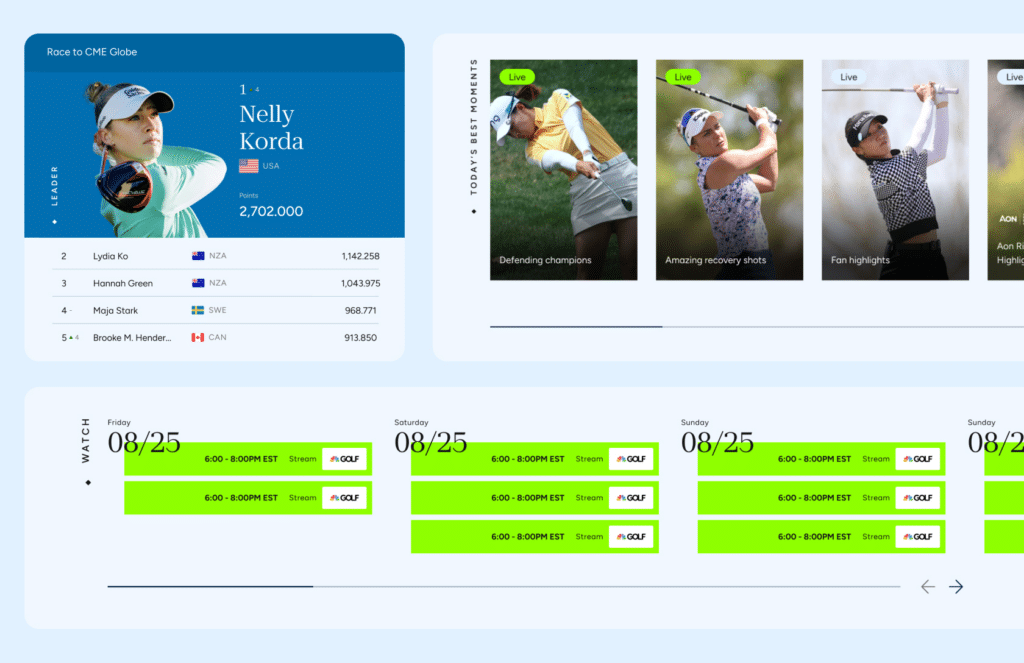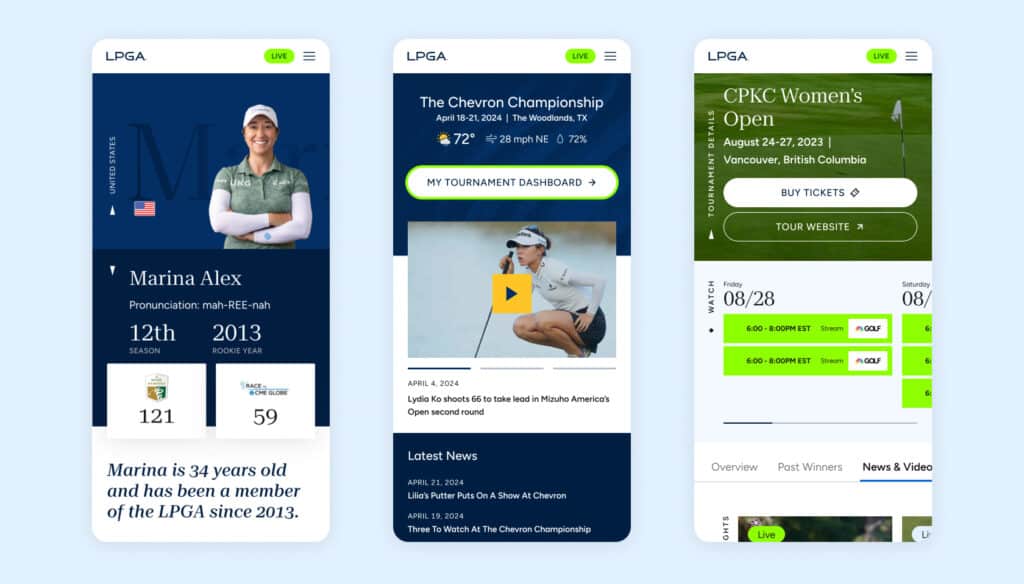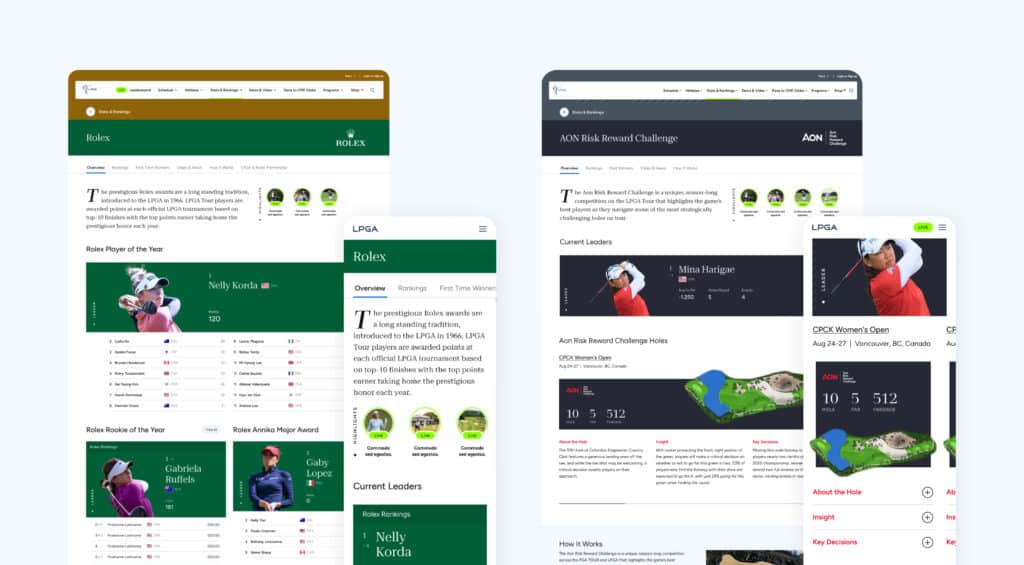“Make it badass”
LPGA.com—creating an experience worthy of the world’s best athletes.
Hero Digital has been working with LPGA for nearly seven years, winning the privilege of working on the website and app for one main reason: we understood what had to be done.
Yeah, we understood the technical stuff. And the design stuff. And the strategy, usability, marketing… all the usual stuff. But most importantly, we knew…
We had to make a totally badass site
Like the LPGA itself, we understood that all of women’s sports is experiencing unprecedented highs—viewership, attendance, higher engagement levels than men’s sports,1 and a forecast that shows, for the first time, women’s elite sports will generate over $1B in revenue in 2024.2
What we heard:
“So much of women’s sports depends on this site to be a success.”
“Women’s sports, in general, are experiencing phenomenal momentum. The LPGA can’t ride it. We want to fuel it.”
“All eyes are on this.”
What we did:
So, what, exactly, does “Badass” mean?
To find out, we did something that lots of digital agencies don’t do — we went out and talked with the fans. We didn’t just hire a vendor to organize a focus group. And we didn’t just email the company looking for golfers.


We hit the bricks. We went to golf courses, events, businesses… wherever we could find the fans. And we carefully listened to:
- The Core Enthusiast
- The Engaged Spectator
- The Casual Fan
- Women’s Sports Supporter
- A Tour Player
- An Epson Tour Player
We took everything we heard, and distilled it down to a focused mission statement for the new LPGA.com: World-class athletes deserve an iconic presence.
And Matt Chmura, LPGA CMO, nodded and said, “Now make it badass.”
Badass athletes deserve a badass presence.


Let’s go!
Let’s transform the digital experience.
Let’s define, design, and develop the LPGA’s tournament websites and mobile app, including lpga.com, epsontour.com, and several microsites.
Let’s create a world-renowned global sports and entertainment property that showcases the very best athletes.
Let’s create unparalleled fan and member experiences.
Let’s deliver high-value benefits to partners and strategically grow opportunities for women and girls through golf.


Let’s build it
To create an experience worthy of some seriously badass athletes (and the fans who love them), Hero modernized their tech stack. We built upon a Sitecore foundation with a headless architecture—allowing for more customizations with the front-end design, with fewer constraints.
We created cross-channel customer journeys for three unique personas (the Core Enthusiast, Engaged Spectator, and Casual Fan) and built a new design system.
And we developed onsite tournament features to enrich the attendee experience.


This was a huge effort
And it was made possible by so many awesome people, all united by the same sense of spirit—something that’s very rare with projects of this scope.
From the start, we found LPGA’s mission to be heroic, and their players to be the true heroes. Now, it doesn’t require a hero to appreciate a hero, but it sure does help.
LPGA strives to be a premier destination for fans to experience dynamic stories, unexpected moments, and badass players—and you can experience it right now.
“All eyes” were on this. The LPGA needed a partner to elevate the digital experience to a level worthy of the players. We’re honored, humbled, excited, and, yeah—we’re proud that they chose us.
1 “What’s next for women’s sports…” Nielsen Insights, July 2024. Accessed September 5, 2024.
2 “Women’s elite sports: Breaking the billion-dollar barrier.” Jennifer Haskel, Paul Lee, Amy Clarke, Pete Giorgio for Deloitte Insights. Accessed September 5, 2024


When hype obscures risk
How can we make sure we’re using Generative AI responsibly?
Be careful what you wish for…
Such sage advice litters the monologues of B-movie villains and wizened mentors alike, but it’s also appropriate for the Generative AI boom. How often have we longed for the easy “computer” prompts of Star Trek, the simple “enhance” of crime footage in procedural dramas, or even to skip four years of art school and decades of training to produce something that looks a lot like the work of famed sci-fi/fantasy illustrator Michael Whelan.
Yes, this is the future we have wished for. But now that we’ve arrived, perhaps we feel a twinge of regret, much like my colleagues who asked the resident AI skeptic to write an article critiquing this technology.
Look, there’s definitely a place for AI
Before we get super-skeptical, let’s start here: we welcome this future — and we welcome it responsibly.
Really — AI, in its various forms, has some very valid, worthy use-cases. Machine learning, for example, has massive value in medical and sociological research. Natural language tools can be extraordinarily helpful as disability accommodations. And we’ve all used spellcheck and machine translation for decades. There’s a million ways this will help millions of people, and there are a million other articles to cover that.
But the real hype today is around Generative AI—giving people the ability to create new text and images from terabytes of training data, and some simple (or not-so-simple) prompts.
However, reality is beginning to catch up to the hype. In recent weeks, AI giant Nvidia has lost 26% of its market value, a loss totaling about $900 billion. This event might prompt us to question why investors would be so quick to shed this much-lauded tech.
First, let’s talk about accuracy
One of the oft-touted benefits of tools like ChatGPT is that you can simply ask it a question, and it will respond. Unfortunately, this perspective demonstrates a complete misunderstanding of how generative AI works and therefore how easy it is for it to “hallucinate” or simply serve up incorrect information.
Unlike other forms of computing, generative AI is not optimized for accuracy but more for what is the most probable configuration of words or pixels based upon the training data. So, even if the training data is completely correct—by no means a reliable assumption—the tool may simply configure its output in such a way as to deliver a factually inaccurate response. This is why Google’s AI Overviews have been caught telling users to put glue on pizza or eat a rock a day for health, and why ChatGPT struggles mightily to solve simple math equations.
And sometimes the consequences can be even more serious. For example, a generative AI-powered chatbot that was designed to provide support to people struggling with eating disorders had to be disabled when it began dispensing dangerous advice.
Widespread sharing of AI-generated misinformation can enable bullying and defamation, endanger the democratic process, and damage public faith in formal expertise. And some of this false output is then fed back into the training data for future prompts, causing the tool to further degrade. The dangers of inaccuracy alone should be enough to give us pause.
Secondly, ethics issues
Because the training data itself has been mostly created by humans with human biases, generative AI tools inherit these biases and then propagate them through their output. AI-generated imagery often displays harmful racial, cultural, and gender stereotypes, as well as unrealistic or fetishized body types. Attempts to mitigate these results have met with little success, and in some cases have prompted pushback from groups that benefit from historic bias (hello, straight white men).
Even worse, attempts to make generative AI tools less toxic require humans to review reams of harmful content, for which some companies have resorted to exploitative labor practices in developing nations.
Then, there is the thorny issue of artistic copyright. Generative AI models require massive amounts of training data to function as intended, and since so much creative intellectual property is readily available online, some companies have simply sucked this all up with a “beg-forgiveness-rather-than-ask-permission” attitude.
Artists and authors may not have given consent to use their work in training data at all, or they may be coerced to agreeing. Compensation is minimal or nonexistent. Not only did this exact issue factor heavily into last year’s Writers Guild of America (WGA) strike, but countless copyright cases continue to work their way through the legal system, representing huge costs to organizations and individuals alike.
Of course, this has not stopped some businesses from laying off employees in the belief that generative AI tools can cheaply replace their labor. While estimates vary, and there are of course multiple causes for rising unemployment in the tech sector, layoffs in tech currently number more than 100,000 in 2024 alone, and Goldman Sachs has made the bold claim that as many as 300 million jobs could eventually be lost or negatively impacted by the rise of generative AI.
And, of course, the environmental cost of generative AI
These have proven to be monumental — requiring enormous data processing centers, power, and water for cooling. AI research company Hugging Face claims it costs about 30 times as much energy to generate text as just extracting it from a source, meaning that asking an LLM like ChatGPT for an answer will cost 30 times what simply asking a search engine will (sans AI summaries, of course).
On a global scale, this means the power demand has more than doubled, even outstripping the available renewable energy in some countries. This will obviously place a huge strain on the already out-dated and overstretched power grid.
Further, these data centers require millions of gallons of water for cooling, diverting that water from other vital needs. One study found that every 10-50 prompt responses uses the equivalent of a 16oz bottle of water. In a time when nations and organizations are working to reduce the increasingly visible impacts of climate change, unhindered use of generative AI threatens to set us back even farther.


The uncertain economic future of AI
Despite investor enthusiasm for generative AI, there seems to be little to no consumer demand for the technology at all, and some studies now suggest that advertising AI actually makes a product less appealing to consumers.
For example, during the Paris Olympics, the backlash to one generative AI ad was so strong that Google pulled it completely. And those much-vaunted worker efficiencies don’t seem to be materializing, either: in a recent study, 77% of employees report that AI is increasing workloads, hampering productivity and contributing to employee burnout. In other words, generative AI is causing productivity losses rather than the much-touted gains.
With the recent stock market volatility mentioned above, along with the recent executive exodus from leaders such as those at OpenAI, it seems that there’s really only one path forward to a productive use of generative AI.
It’s time for stark honesty about the risks and benefits
This is a judgment call that each individual and organization will have to make for themselves, but in general, we can ask ourselves these questions:
- Could inaccurate output endanger someone’s safety or perpetuate discrimination?
- Given the need to fact-check or refine the result, how much time will actually be saved?
- What is the cost to the environment in energy and water consumption? Does the value generated justify this impact?
- Was this tool ethically trained with full consent and compensation of the original content creators?
- Does this tool rely on any exploitative labor practices?
Let’s keep this conversation going
With these questions in mind, we’re working hard to ensure that we’re using generative AI responsibly, ethically, and efficiently. Our goal, as always, is to deliver the best possible results to our clients.
At Hero, we solve your hardest problems. For AI, this means an honest and open approach where we push our own practices safely into the future.
Want to share your thoughts? Get in touch.


Factfulness: Ten Reasons We’re Wrong About the World — and Why Things are Better Than You Think
by Hans Rosling, Ola Rosling, Anna Rosling Rönnlund,
A book review by Michelle Berryman
If you are reading this post, odds are that you live a life unimaginable by kings even 100 years ago. You likely have a smartphone that is just as good (or better) than those carried by Richard Branson, Bill Gates, Jack Ma, Jeff Bezos, [insert name of your favorite ultra wealthy person here], etc. In fact, it’s doubtful anyone can buy a smartphone that’s truly better than the one you carry. Newer? Yes. Better? Marginally, perhaps. That’s fairly remarkable to contemplate.
Yet, with all the turmoil in the world today — an ongoing war in Ukraine, a growing economy that inextricably feels sluggish, the US Presidential race, the recent Crowdstrike global IT outage, etc. — it can sometimes be challenging to remember just how good things really are for most of us, and in the world, generally.
In his final work, Hans Rosling dissected many of our misconceptions about the world around us, providing new perspectives and frameworks for thinking about everything. If you are curious and open minded, Factfulness: Ten Reasons We’re Wrong About the World — and Why Things are Better Than You Think is a fascinating read. It will challenge your assumptions in a good way. For instance, Rosling posits there is no more “us” and “them,” no more “developed world” and “developing world.” Rather, he proposes thinking of the world in four income groups:
- Group 1 consists of one billion people who live on less than $2/day. They commute on foot, generally barefoot. They cook on an open fire and sleep on a dirt floor.
- Group 2 is the largest group with three billion people living on an income of $2 – $8/day. This affords shoes, a mattress, a gas stove and schools for their children.
- Group 3 comprises two billion people, surviving on an income of $8 – $32/day. They have running water, motorized transportation and perhaps a refrigerator.
- Group 4, where we reside, contains one billion people fortunate enough to live on more than $32/day. People in Group 4 likely have a car, a high school diploma and are able to take vacations. Group 4 has disposable income.
Each income group represents a significantly better quality of life than the previous one. The income groups are not divided up by geography, nor bounded by lines on a map designating countries or territories. Many countries straddle all four income groups. Bill Gates considered this framework a “revelation” in understanding the world around us. In fact, Gates was so taken with Factfulness and the ideas, like this one, contained within the book that in 2018, he offered free copies to all new graduates of US colleges and universities.
Rosling also examines how the media systematically skew data and trends to make people think the world is getting worse, all for the service of ratings and viewership. By examining ten common “dramatic” instincts, Rosling scrutinizes a series of familiar misconceptions and how we’ve come to accept many of these myths as facts. He then discusses each of the ten instincts with additional real world examples and actionable rules of thumb for critical thinking and seeing through the drama.
The book is six years old, but still very relevant. The concepts are not time-bound and the calls to action still resonate. The world really is better than we realize. Let’s be open to having our assumptions challenged. There is still plenty we can — and should — do to make the world a better place, however. Starting with actively embracing reality, let’s work on the actual gaps and opportunities instead of the perceived gaps.
To explore the income groups in greater detail, check out and contribute to Dollar Street, an ongoing project led by Rosling’s Gapminder organization. The site features photos and videos of 469 families in 67 countries at various income levels so we can see what life really looks like around the world today.
And, of course, if you want to know more about Hans Rosling and how he saw the world, his TED talk is a classic. He was also famous for swallowing swords on stage.


FACEPALM: The Tortured Poets review rebuttal
An album Review by Kelsey Storkamp
Read it if you must, but let’s just say that an old(er) man reviewing music without realizing the songs were about men like him…well, the irony isn’t lost on a single Swiftie. And, needless to say, I have a different take.
First, a little context:
I am a 37-year old woman. This is important because I am…an elder Swiftie. I’ve had years of practice getting through breakups while running the lakes of Minneapolis to Swift’s music. And her music is meant for me, and the multi-generational fan following she has garnered.
Let’s start with the numbers
65 minutes and 8 seconds. That’s how many stories she has to tell. That’s why she just filed a trademark for “Female Rage: The Musical.”
The Tortured Poets Department (TTPD) is a tapas menu of emotional permission, serving up taste after taste of lyrical lived experiences and emotional honesty, and it’s left for the listener to interpret the meaning based on their own lives (29:20). Sorry metalheads, you won’t find a buffet of growls, but you might find some thunderous riffs of rage (1:00). But every minute of this album, and every topic she writes about, has shifted millions of fans’ perspectives on the value of boundaries, self-worth, and the importance of turning your location tracking off post breakup (IYKYK).
“So Long London”
TTPD is a culmination of all the emotions she’s experienced during many of her very real — and publicly lived — experiences. No song is more raw and heart wrenching than “So Long London.”
Take this lyric, for example: You say I abandoned the ship, but I was going down with it. It’s a perfect metaphor for anything we need it to be about. And that’s what is so brilliant about Swift’s songs — that they can shape-shift to help you articulate how you feel about a relationship, work, an addiction, or whatever you’re struggling with but you can’t quite find the words to describe how you feel.
“I Can Do It With a Broken Heart”
This is one of the catchiest songs on the album, though it was apparently “lost in the shuffle” of my colleague’s review. This song embodies the forced power dynamic and emotionally dismissive demand of the phrase “why don’t you just smile more?”
If you haven’t heard this song blaring out of a Ford Escape while the driver sips on a PSL, do you even drive? Call us basic but do not underestimate our ability to fake it till we make it. (Don’t try and come for our job (00:10) (IYKYK)
“Imgoingtogetyouback”
I have no idea why it’s spelled like that, but I bet another Swiftie has decoded it. The only thing I want to say about this beautiful slow jam of a song is how incredible the bridge is (02:13). *Chief’s kiss*. I mean *chef’s kiss.*
Overall Thoughts
Last month’s review of TTPD suggested Swift take a cue from Beyoncé’s successful transition into country music. I don’t need to explain the irony there given the path Swift has taken. I won’t be comparing Beyonce to Taylor Swift, but I will say that Taylor is continuing to do something radical: she’s giving permission to one of the widest audiences — across vast genres of music, from young girls and elder Swifties like myself — to own their emotions, to speak out, and to demand respect.
It gives their seemingly everyday emotions validity, dignity. It makes them feel seen.
She’s giving voice to the very feelings that society often tells women to suppress.
Examples of this Swiftolution happens weekly. Fans in Vienna last month who, despite a serious threat that canceled her show, gathered in droves and filled the streets with songs from The Eras Tour setlist by blasting them from church speakers. Her songs are anthems and lifelines.
So, while our resident metalhead brought a sledgehammer to a bracelet-making party, Swift’s intricate craftsmanship deserves to be seen through the eyes of someone who not only resonates with her music — but can also shed light on its significance for those who might not understand.
P.S. Taylor Swift DID IN FACT RAP on her Reputation album
That album is set to be re-recorded and re-released because her original masters…OK, I have to get back to work. Maybe more on this in the next newsletter.